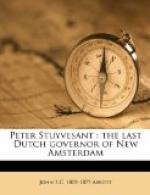As soon as it was known, at Plymouth and Boston, that the Dutch had taken formal possession of the valley of the Connecticut, Governor Winslow hastened to confer with the Massachusetts Governor respecting their duties. As it was doubtful whether the region of the Connecticut was embraced within either of their patents, they decided not to interfere. But through diplomatic policy they assigned a different reason for their refusal.
“In regard,” said Governor Winthrop,
“that the place was not fit for plantation, there being three or four thousand warlike Indians, and the river not to be gone into but by small pinnaces, having a bar affording but six feet at high water, and for that no vessel can get in for seven months in the year, partly by reason of the ice, and then the violent stream, we thought not fit to meddle with it."[4]
Still Governor Winthrop looked wistfully towards the Connecticut. Though he admitted that the lower part of the valley was “out of the claim of the Massachusetts patent,” it could not be denied that the upper part of the valley was included in their grant. In the summer of 1633, John Oldham, with three companions, penetrated the wilderness, through the Indian trails, one hundred and sixty miles to the Connecticut river. They were hospitably entertained in the many Indian villages they passed through by the way.
They brought back early in the autumn, glowing accounts of the beauty of the region, and of the luxuriant meadows which bordered the stream. Governor Winthrop then sent a vessel on a trading voyage, through Long Island Sound, to Manhattan, there to inform the Dutch authorities that the king of England had granted the Connecticut river and the adjacent country to the subjects of Great Britain.
In most of these transactions the Dutch appear to great advantage. After five weeks’ absence the vessel returned to Boston to report the friendly reception of the Massachusetts party at Manhattan, and bearing a courteous letter to Governor Winthrop, in which Van Twiller, in respectful terms, urged him to defer his claim to Connecticut until the king of England and the States-General of Holland should agree about their limits, so that the colonists of both nations, might live “as good neighbors in these heathenish countries.” Director Van Twiller added, with good sense, which does him much credit:
“I have, in the name of the States-General and the West India Company, taken possession of the forementioned river, and, for testimony thereof, have set up an house on the north side of the said river. It is not the intent of the States to take the land from the poor natives, but rather to take it at some reasonable price, which, God be praised, we have done hitherto. In this part of the world there are many heathen lands which are destitute of inhabitants, so that there need not be any question respecting a little part or portion thereof.”




